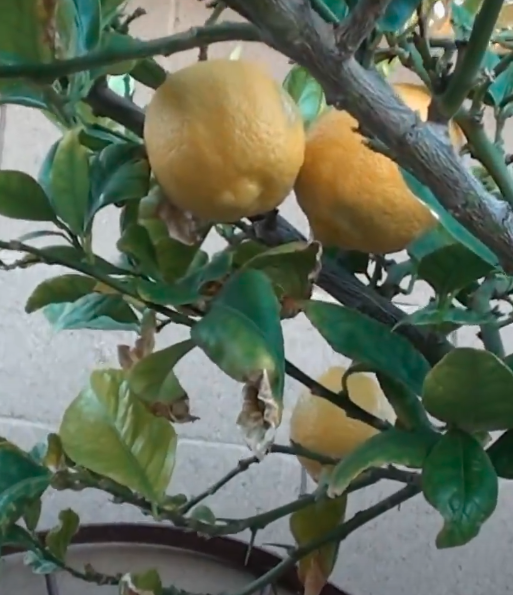Lisbon Lemon (Citrus × limon ‘Lisbon’) – Cultivar Profile & Grower’s Guide
Variety Name & Synonyms
Official cultivar name Citrus × limon ‘Lisbon’ (numerous clonal lines such as ‘Prior Nucellar’, ‘Limoneira 8A’) Common / local names Lisbon lemon, Portuguese lemon
Origin & History
Ancestry & region: Selected in Portugal from the old ‘Gallego’ lemon; seed introduced to Australia (1824) and California (1840s). Commercial rise: Widely planted in California & Australia from the late-19th C for winter production and greater cold- & heat-tolerance than ‘Eureka’.
Tree Characteristics
Mature height & canopy spread 3 – 4.5 m tall × 3 – 3.6 m wide (standard rootstock). Growth habit Vigorous, upright–dense; notably thornier than ‘Eureka’; fruit borne mostly inside canopy, reducing wind- and sunburn. Cold-hardiness Withstands brief frosts to ≈ –5 °C; rated one of the most cold-tolerant true lemons.
Fruit Description
Size / weight 5 – 8 cm long, average 100 – 140 g. Shape & rind Oblong–elliptical with pointed nipple; moderately thick, smooth-to-finely pitted rind rich in oil glands. Colour at maturity Bright lemon-yellow. Juice & acidity High juice yield (≈ 30 % wt); pH ≈ 2.6 – 2.9 (citric acid 4 – 6 %).
Flowering & Harvest Profile
Flowering: Major bloom late winter-early spring (Bangladesh: Feb–Mar); lighter flushes possible after summer rains. Harvest windows: Main crop Nov – Mar in subtropics; off-season pick possible nearly year-round in warm zones. Typical yield: Well-managed mature trees produce 80 – 120 kg (≈ 600 – 1 000 fruit) per season; wide spacings can out-yield ‘Eureka’ by ≈ 25 %.
Soil & Climate Preferences
Soil: Deep, well-drained sandy-loam or loam, pH 5.5 – 6.5; good performance even on heavier clay if raised beds are used. Sunlight: Full sun (≥ 6 h) essential for juice and oil development.Water: 800 – 1 200 mm annual ideal; maintain even moisture—avoid water-logging and prolonged drought.
Planting & Spacing
Orchard spacing: 4 m × 4 m on vigorous rootstock; 3 m × 3 m for dwarf lines.Best planting season in Bangladesh: Early monsoon (Jun–Jul) on 30 cm-high ridges; secondary window Nov–Dec with irrigation backup.Container culture: Performs well in ≥ 50 L tubs—moveable for cyclone or frost protection.
Care & Maintenance
Task Recommendation Reference Fertiliser regimen Balanced citrus feed 10-10-10 (or 14-7-14) split Feb, Jun & Oct; mature tree ≈ 600 g N yr⁻¹. Pruning Light structural pruning post-harvest; remove interior deadwood & water-shoots; manage thorny shoots early. Irrigation Deep-water 25 – 30 L per tree every 7-10 days in dry months; mulch 5 cm compost to limit evaporation. –
Pest & Disease Susceptibility
Issue Susceptibility Controls Citrus leaf-miner, scale, aphids Medium Neem or horticultural oil at 14-day intervals when flush is tender. Citrus canker Medium Copper oxychloride sprays; sanitise tools. Huanglongbing (greening) Region-dependent risk Control psyllids, rogue infected trees.
Propagation Method
Seed: Poly-embryonic; seedlings mostly true-to-type but 5 – 6 yrs to bearing.Grafting: Preferred—Lisbon scion on Poncirus trifoliata or rough-lemon confers soil disease & cold resistance; fruiting in 2 – 3 yrs.Cuttings / air-layers: Viable for hobbyists with mist propagation (rooting in 6–8 weeks).
Culinary & Commercial Uses
Fresh uses: Classic tart juice & zest for lemonade, marinades, dressings, ceviche, pastries.Value-added: Marmalade, candied peel, natural cleaning agents, essential oil for food & cosmetics.
Suitability in Bangladesh – One-Paragraph Summary
Lisbon lemon is exceptionally well-suited to Bangladesh’s subtropical monsoon climate: its superior cold-tolerance sails through the nation’s mild winters while vigorous growth and dense foliage shield fruit from hot, desiccating winds, yet success hinges on planting trees on raised, free-draining ridges or tubs to escape monsoon water-logging, providing at least six hours of full sun, and maintaining steady moisture February–April when dry spells coincide with flowering; coupled with balanced 10-10-10 citrus nutrition, light post-harvest pruning, and neem-based control of leaf-miner and scale, grafted Lisbon trees can reliably deliver 80–120 kg of high-acid, premium lemons per year—meeting demand from restaurants, juice processors, and export buyers looking for classic, tart flavour.
Price & Availability (Bangladesh)
Grafted saplings: BDT 300 – 1,200 (local nursery pricing). Suppliers: Bangladesh Agriculture Nursery (Dhaka), local specialty citrus centres, and international vendors.
References
Givaudan Citrus Variety Collection, University of California Riverside – “Limoneira 8A Lisbon lemon .”Specialty Produce – “Lisbon Lemons: Information and Facts.” Citrus Australia – Lisbon Lemon Variety Fact Sheet (PDF). NSW Department of Primary Industries – Growing Lemons in Australia: Lemon Varieties (production manual extract).The Garden Magazine – “When Do Lemon Trees Bloom? Bloom Period for Different Lemons.” Wikifarmer – “Lemon Tree Yield, Harvest, and Storage.” Plantmark Wholesale Nursery – “Citrus limon ‘Lisbon’ – plant profile.”Gardenia.net – “Lisbon Lemon: Health Benefits, Uses, Growing Tips.”Lemon Paraiso – “Lisbon Lemon Tree: Planting, Care, Pest and Disease Management.” Rennie Orchards – “Best Fertilizer for Lemon Trees: Top Picks & When to Apply.” Better Homes & Gardens (Australia) – “How to Control and Prevent Citrus Leaf-miner.” Bangladesh Agriculture Nursery – Lisbon Lemon sapling listing & price. ABC Gardening Australia – “Love Your Lemons” (variety overview). The Spruce – “How to Grow and Care for Lemon Trees.”

